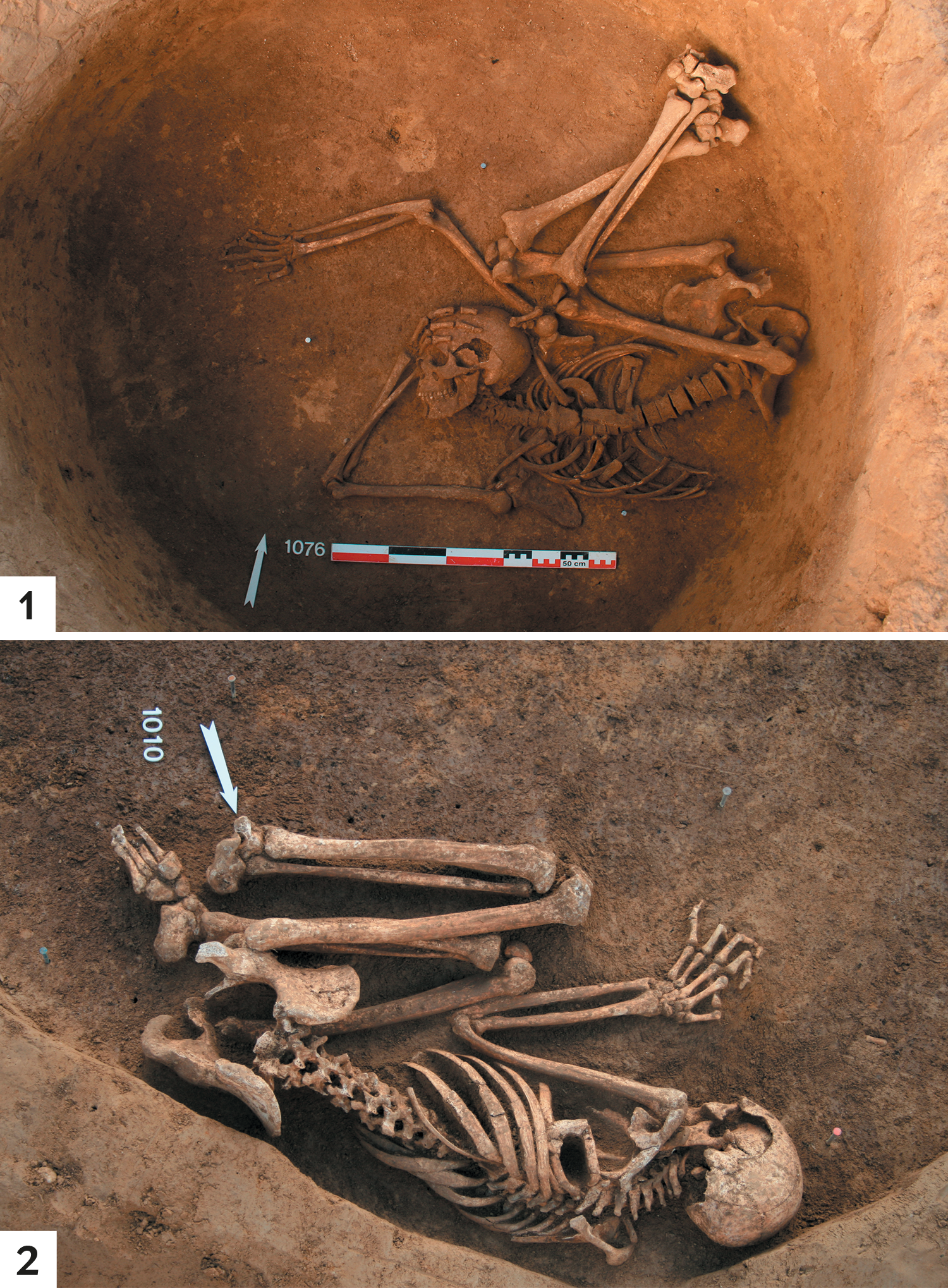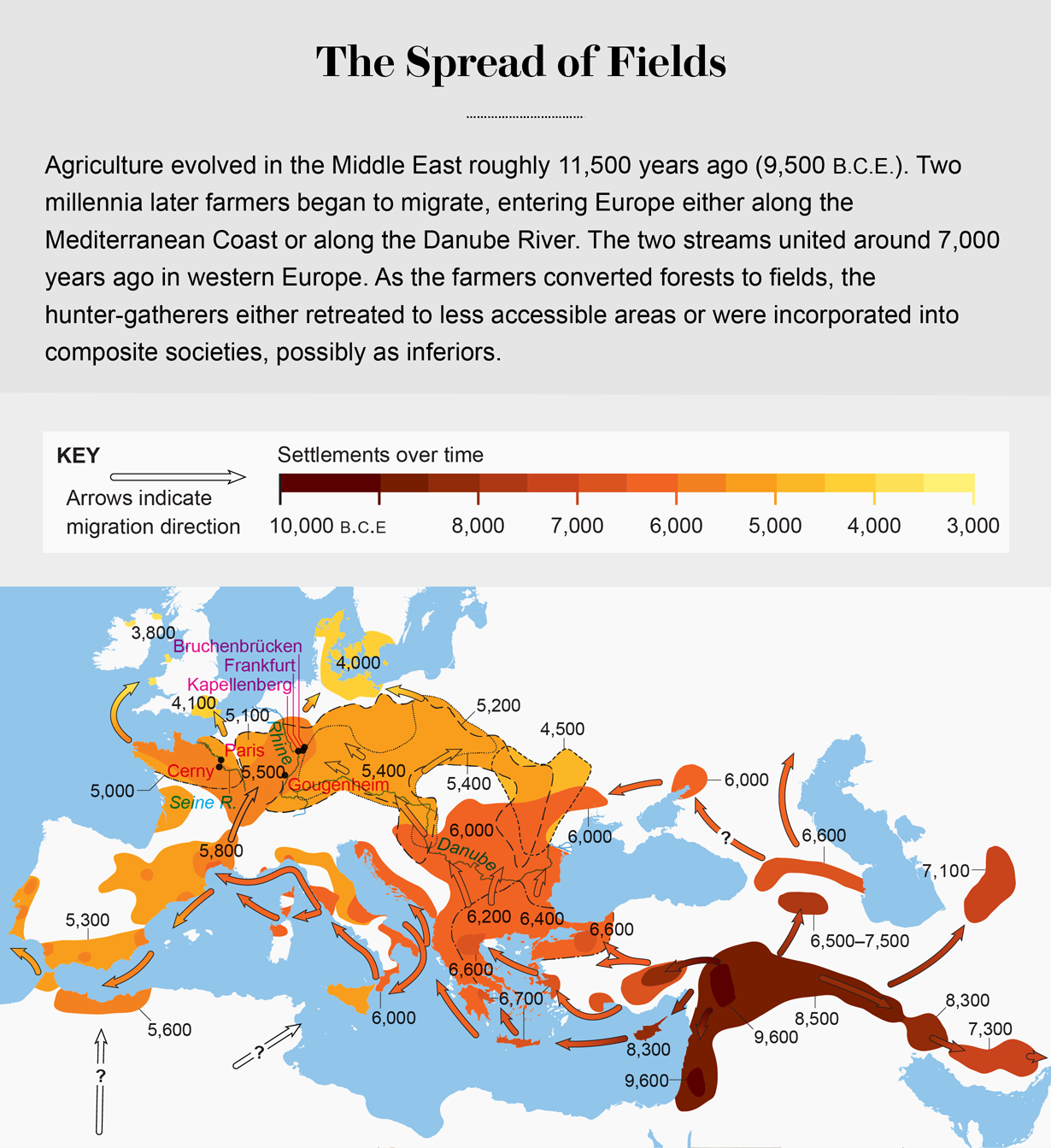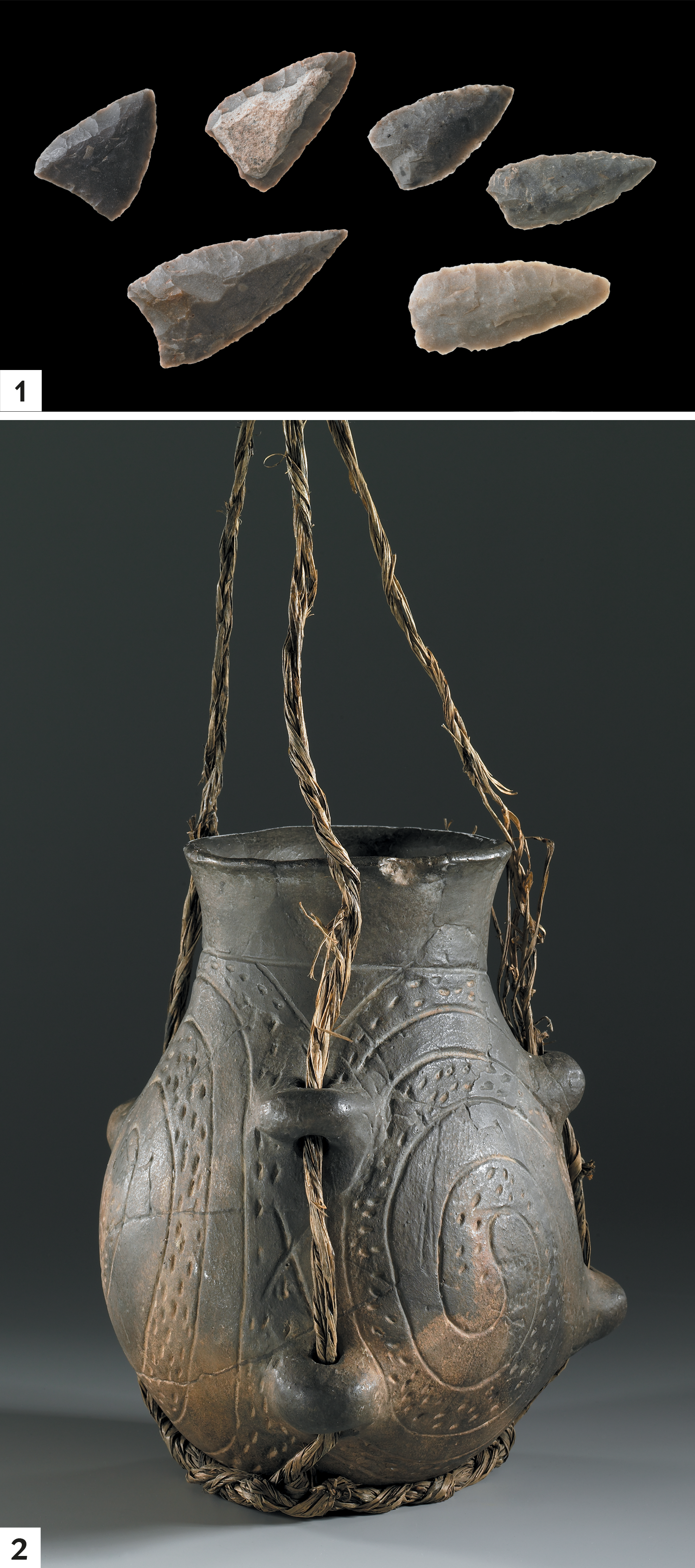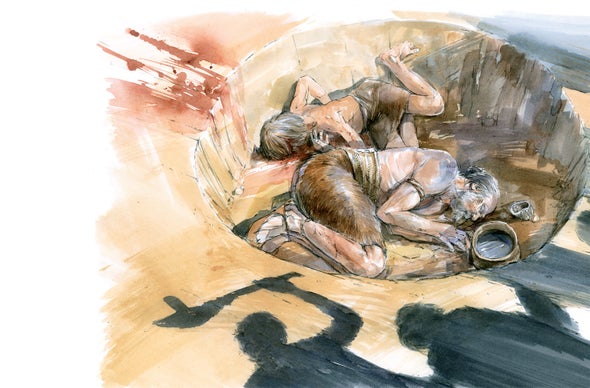Eight thousand years ago small bands of seminomadic hunter-gatherers were the only human beings roaming Europe's lush, green forests. Archaeological digs in caves and elsewhere have turned up evidence of their Mesolithic technology: flint-tipped tools with which they fished, hunted deer and aurochs (a now extinct species of ox), and gathered wild plants. Many had dark hair and blue eyes, recent genetic studies suggest, and the few skeletons unearthed so far indicate that they were quite tall and muscular. Their languages remain mysterious to this day.
Three millennia later the forests they inhabited had given way to fields of wheat and lentils. Farmers ruled the continent. The transition was evident even to 19th-century archaeologists, whose excavations revealed bones of domesticated animals, pottery containing remnants of grain and, most intriguing of all, graveyards whose riddles are still being solved. Agriculture not only ushered in a new economic model but also brought about metal tools, new diets and new patterns of land use, as well as novel human relationships with nature and with one another.
For 150 years scholars debated whether the farmers brought their Neolithic culture from the Middle East to Europe or whether it was only their ideas that traveled. In the early 2000s, however, geneticists such as Martin Richards, then at the University of Oxford, and others studied patterns of variation in modern genes to provide irrefutable proof that the farmers came—streaming across the Aegean Sea and the Bosporus to reach Greece and the Balkan Peninsula, respectively. From there they spread north and west. Then Svante Pääbo of the Max Planck Institute for Evolutionary Anthropology in Leipzig, Germany, and others learned to extract DNA from ancient human remains and read it. This technological revolution enabled an unprecedented collaboration between archaeologists and geneticists, who rushed to characterize the DNA of individuals who had died in prehistoric hunter-gatherer or farmer settlements.
Since 2014, when archaeologist Cristina Gamba, then at Trinity College Dublin, and her colleagues found a hunter-gatherer bone in an early farming community in Hungary, a bewilderingly complex and multifaceted picture of the encounters between the residents and the immigrants has emerged. In some places, the two groups mingled from the time they met; in others, they kept their distance for centuries, if not millennia. Sometimes the farmers venerated their predecessors; at other times they dehumanized and subjugated them. Nevertheless, a clear trend is evident. As the decades passed and farmers increased in number, they assimilated and replaced the hunter-gatherers, pushing those who held out to the margins—both geographically and socially. Disturbingly, the progression toward greater inequality culminated, in at least a few places, in societies in which individuals with greater hunter-gatherer ancestry may have been enslaved—possibly even being sacrificed to accompany their masters to the afterlife.
The Exodus
Roughly 11,500 years ago Europe and the Middle East were emerging from an ice age. As the weather grew warmer and the land more bountiful, hunter-gatherers in the so-called Fertile Crescent—an envelope of land around the Euphrates, Tigris and Nile Rivers and the eastern coast of the Mediterranean Sea—gradually became more sedentary. They spent less of their time hunting wild ibex and boar and gathering wild grasses, and they spent more of it tending their own domesticated animals and plants: sheep, goats, wheat, peas and lentils. Archaeobotany—in particular the study of ancient pollen—and archaeozoology, the study of ancient animal bones, revealed this transition. These were the first farmers, people who spoke unknown languages (of which Basque could be a relic), used stone tools and, about 9,000 years ago, headed for Europe in search of new land to cultivate.
The farmers reached the new continent by two routes: in boats via the Mediterranean and on foot along the Danube River from the Balkans into central Europe. Radiocarbon dating of archaeological sites revealed that by about 7,500 years ago, Danubian farmers were building villages in the Carpathian Basin—modern-day Slovakia, Hungary and Romania—and there they began creating a pottery culture. Archaeologists call it the Linear Pottery culture (LBK, by its German acronym, for Linearbandkeramik) because of the distinctive spiral motifs with which they decorated their ceramics.
Traveling rapidly westward across the fertile plains of what is now Germany, the LBK farmers reached the Rhine within just a few centuries, around 7,300 years ago. Fine-grained analysis of the evolution of pottery styles, along with radiocarbon dating, suggests that they practiced a form of leapfrog colonization. They took “stepwise movements with sometimes hundreds of kilometers covered, and then the landscape in between filled up,” says archaeologist Detlef Gronenborn of the Römisch-Germanisches Zentralmuseum (Romano-Germanic Central Museum) in Mainz, Germany. At some point they learned how to smelt copper, and a trade in precious copper objects sprang up between farming communities.
On the southern route, the farmers leapfrogged along the Mediterranean coast from Italy to France and on to the Iberian Peninsula. After reaching French shores, 7,800 or so years ago, they migrated northward toward the Paris Basin, the plain between the Rhine and the Atlantic Ocean that forms a kind of continental cul-de-sac. It was there that the two great streams of farmers met, around seven millennia ago. By then their cultures had diverged to some extent—they had been separated for more than 500 years—but they would still have recognized their own kind. They mingled both biologically and culturally.
A cemetery near Gurgy, in the southern part of the Paris Basin, dating from 7,000 years ago provides a snapshot of that mingling. Mitochondrial DNA (mtDNA) is typically inherited via the maternal line, and the mtDNA of about 50 individuals buried there has roughly equal contributions from LBK and southern farmers. From the Paris Basin, this mixed population spread out again—carrying its farming culture to every corner of the continent.
Fields over Forests
The first farmers to enter Europe probably came with their families, as revealed by a 2017 study by Amy Goldberg, an evolutionary anthropologist then at Stanford University, and her colleagues. They analyzed the X chromosomes of 20 Neolithic Europeans. Unlike a Y chromosome, which can be inherited only from a father, an X chromosome can be inherited from either parent. Goldberg's team reported that male and female farmers had contributed X chromosomes to the 20 individuals in roughly equal proportions. Other researchers have concluded that these societies were patrilocal, meaning wealth was passed down the male line and women married in from outside. Clues to the mobility of women come from the ratio of strontium isotopes in their teeth, which reflect their dietary history, and from the constant influx of outside artistic influences into farming communities, as evinced by their pottery. Women are thought to have decorated the pottery, as in agricultural societies of later eras.

Europe then was slightly wetter and warmer than it is today and was heavily forested. As with all immigrants, the farmers might have taken a while to adapt to their new environment, but gradually they learned which plants and animals thrived in Europe's temperate climes. They cleared the forest parcel by parcel and shaped its composition using ancient forest-management techniques such as coppicing and pollarding. (Coppicing involves cutting a tree back to its base and then allowing it to produce multiple new stems; pollarding is pruning of just the upper branches.) The farmers' numbers began to increase. When there was no more room at a farm, the younger generation moved on, settling in what may have seemed to them virgin forest. “The newcomers might not have had the impression of encroaching on anybody else's territory,” says Céline Bon, a paleogeneticist at the Museum of Mankind in Paris. But they were.
Sooner or later the immigrant farmers must have met the resident hunter-gatherers—and when it happened, it must have been a shock. Approximately 40,000 years had elapsed since their common ancestors split paths on their way out of Africa—long enough to distinguish them physically, culturally and linguistically. Comparisons of their genes with those of modern Europeans indicate that the farmers were shorter than the Western hunter-gatherers who occupied most of the continent. They also had dark hair, dark eyes and, probably, lighter skin. There is no evidence of violence between the two groups in the earliest encounters—although the archaeological record is incomplete enough that violence cannot be ruled out. Yet in large parts of Europe, the hunter-gatherers and their Mesolithic culture simply vanished from both genetic and archaeological records the moment the farmers arrived. Where did they go?
For decades archaeologists have wondered whether, in the face of this massive influx, the hunter-gatherers retreated—into the hills, perhaps, where the soil was less fertile and hence less suitable for farming, or deep into the forest, where the farmers were unlikely to interfere with them. “Maybe there were massive pockets of hunter-gatherers surviving there, not for a generation but for 1,000 or 2,000 years after the farmers arrived,” suggests Ron Pinhasi, an archaeologist and anthropologist at the University of Vienna in Austria.
The hunter-gatherers must still have been there somewhere because modern Europeans carry their genes, and Europe-wide surveys of ancient DNA have highlighted a so-called Mesolithic resurgence that started 6,500 years ago. Hunter-gatherer genetic elements accounted for more and more of the farmers' genomes as time went on—but the resurgence was not just genetic. “Around the same time, we see the reemergence in the archaeological record of Mesolithic ways of doing things,” says archaeologist Thomas Perrin of the Jean Jaurès University of Toulouse in France. The hunter-gatherers themselves were no longer there, except for possible pockets of them hiding deep in the forest—but their genes, and their technology, were.
By the time the farmers started moving out again from that hub of the Paris Basin, they were no longer the same people who had set out from Hungary or beached on Europe's prehistoric Riviera. They carried a little bit of the old Europe within them. And that raises the question: How did the encounter between such disparate peoples unfold?

A Kaleidoscope
The answer is: in a kaleidoscope of different ways. There is no clear genetic evidence of interbreeding along the central European route until the LBK farmers reached the Rhine. And yet the groups mixed in other ways—potentially right from the beginning. A tantalizing hint of such interactions came from Gamba's discovery of a hunter-gatherer bone in a farming settlement at a place called Tiszaszőlős-Domaháza in Hungary. But there was nothing more to be said about that individual. Was he a member of that community? A hostage? Someone passing through?
With later evidence, the picture became clearer. At Bruchenbrücken, a site north of Frankfurt in Germany, farmers and hunter-gatherers lived together roughly 7,300 years ago in what Gronenborn calls a “multicultural” settlement. It looks as if the hunters may have come there originally from farther west to trade with the farmers, who valued their predecessors' toolmaking techniques—especially their finely chiseled stone arrowheads. Perhaps some hunter-gatherers settled, taking up the farming way of life. So fruitful were the exchanges at Bruchenbrücken and other sites, Gronenborn says, that they held up the westward advance of farming for a couple of centuries.
There may even have been rare exceptions to the rule that the two groups did not interbreed early on. The Austrian site of Brunn 2, in a wooded river valley not far from Vienna, dates from the earliest arrival of the LBK farmers in central Europe, around 7,600 years ago. Three burials at the site were roughly contemporaneous. Two were of individuals of pure farming ancestry, and the other was the first-generation offspring of a hunter and a farmer. All three lay curled up on their sides in the LBK way, but the “hunter” was buried with six arrowheads.
In 1990, when archaeologists first started excavating Brunn 2, they found it littered with thousands of stone fragments, along with ceramic amphorae and clay flutes and figurines. They concluded that it served as a place of ritual or as a Stone Age workshop and trading post, or both. If it was a sacred place, says Alexey Nikitin, a paleogeneticist at Grand Valley State University in Allendale, Mich., who has worked at Brunn 2, the individuals buried there must all have enjoyed high status. For him, the site attests to mutually profitable interactions between the two cultures. “The incomers brought in something the locals didn't have, but the locals had something that the incomers didn't—knowledge of the landscape,” he says.
On the southern route, however, those interactions seem to have included interbreeding right from the start. “Within the first two centuries of the first farmers' arrival, we have individuals whose genetic makeup is 55 percent hunter-gatherer,” says paleogeneticist Maïté Rivollat of the University of Bordeaux, co-author of a genetic analysis of human remains found at Neolithic burial sites in southern France that was published in May in Science Advances. Moreover, by looking at the way the hunter-gatherer component was distributed through farmer genomes, Rivollat and her colleagues could tell the interbreeding had gone on for five or six generations already—perhaps starting as soon as the pioneers landed.
Curiously, French sites where the two groups might have come into contact are absent, although Perrin has searched for them. The closest he and others have come to putting the farmers and the hunter-gatherers in the same place at the same time is the Grotte du Gardon, a cave in the Jura Mountains east of Lyon, which was occupied in quick succession by Neolithic farmers from the south and by Mesolithic hunters, with the latter moving in after the former. “Given the small separation between these occupations in time, we can conclude that they coexisted in the region, at least,” Perrin says.
How to make sense of these disparate findings? Polly Wiessner, an anthropologist at the University of Utah, who has long studied hunter-gatherers, says that such regional variation is unsurprising. In more recent history, when immigrant farmers encountered an established group of hunter-gatherers, relations between the two depended on their respective economic goals. “If newcomers [want] to colonize land or resources, they dehumanize the residents,” she says. “If there is possibility for cooperation, then the response is to categorize relations to facilitate interaction”—to label the other a friend or a trading partner, that is.
More recent colonizations of hunter-gatherer territory by farmers could also help explain why the Mesolithic resurgence—around 1,500 years after the farmers arrived in Europe—took so long. When Bantu farmers started expanding into southern Africa 3,000 years ago, they encountered the forest-dwelling Pygmies, a group of hunter-gatherers from whom they were as genetically distant as they were from Europeans. “For a long time,” says evolutionary geneticist Lluis Quintana-Murci of the Pasteur Institute in Paris, who has pieced the joint history of these two groups together using ancient DNA, “there were commercial transactions between Bantu and Pygmies but no in[ter]breeding.”
When the interbreeding finally started, more than 2,000 years after the two groups met, it was Pygmy women who married into Bantu communities, where they were—and still are—treated as socially inferior, a lower socioeconomic class that is also differentiated biologically. “Bantus have a double-edged relationship with the Pygmies,” Quintana-Murci says. “On the one hand, they treat them like servants; on the other, they are slightly afraid of them. In the Bantu way of thinking, Pygmies are the masters of the forest, and some of them have shamanic powers.”
Why did the biological barriers come down when they did? Nobody knows, Quintana-Murci says, but it is likely that some social barrier came down first. Perhaps as Bantu society became richer and more stratified, those at the bottom of the social ladder found an affinity to the marginalized Pygmies.
Did a similar lowering of social barriers allow Europe's early farmers and its hunter-gatherers to mix? It is hard to know, but a possible clue is provided by the Cerny culture of the Paris Basin. Archaeologists have long regarded Cerny as a last vestige of LBK, developing just as LBK was embracing other elements. If that premise is correct, the inhabitants had farming in their blood—their ancestors were the early farmers of the Carpathian Basin. Yet in cemeteries dating from 6,700 years ago, men of high status were buried lying on their backs, not curled up on their sides, and arranged around them were hunting weapons and ornaments made from red deer antlers, the tusks of wild boars and the claws of birds of prey. “Their funerary rites speak to another world from their day-to-day,” says archaeologist Aline Thomas of the Museum of Mankind. “They make reference to the sphere of the wild, things that are more often associated with Mesolithic populations.”
Those rites have prompted Thomas and Bon to ask: Who were the Cerny people really? Were they farmers who had adopted Mesolithic ways and come to venerate them, or were they recently converted hunter-gatherers who had never let them go? Bon and Thomas have been analyzing DNA extracted from the Cerny cemeteries to try to answer that question. So far they have analyzed the (maternally inherited) mtDNA and found that it contains Mesolithic elements. At Cerny, therefore, hunter-gatherer women came into the community from outside to marry local men. This influx may reflect what was happening in other farming communities of the period, because by 6,700 years ago the Mesolithic resurgence—the emergence of hunter-gatherer genes in farming genomes—was well underway. So the outstanding question is: Who were the Cerny men? The researchers are analyzing Y chromosomes and whole genomes from Cerny now, in the hope of pinpointing their genetic origins.
Whoever the Cerny people were, their cemeteries seem to provide a freeze-frame of that Mesolithic resurgence in Europe. Within a few hundred years almost everybody in Europe had adopted the farming culture—even if their genes, and occasionally their rituals, told a more complex story.

An Emerging Hierarchy
Around 6,500 years ago a new phase began in Europe. Previously, as at Brunn 2, even important people were buried individually and in the ground. Now, in some regions, huge burial mounds were raised over small chambers in which one or two individuals were interred. Archaeologists think these changes reflect some seismic social shift, perhaps the birth of inequality as farming societies began to generate surplus and distribute it unevenly. If so, those societies now contained people with high levels of hunter-gatherer ancestry who may still have looked different from their “pure” farmer neighbors and whose existence was not necessarily happy.
An example is the Michelsberg culture. Dating from 6,400 years ago, it likely originated in the Paris Basin before farmers moved east toward Alsace and Germany. The people of Michelsberg organized their territory defensively. At the core, typically, was a large fortified settlement inhabited by up to several thousand people. This center was surrounded by a belt of land containing smaller, more dispersed settlements, and beyond that was what Gronenborn calls a “frontier zone” inhabited by even sparser “colonies.” This defensive pattern probably reflected tensions between neighboring communities, which clashed as their populations grew.
Michelsberg burials reveal a stratified society. In some of the sites—for example, at Bruchsal-Aue near Karlsruhe—a high-status individual lies curled up on his side in traditional LBK fashion, with other individuals thrown in apparently willy-nilly around him. The ratio of strontium isotopes in their teeth indicates that all those buried in a single grave were raised on the same diet—a farmer's diet—but their DNA reveals that those surrounding the central figure generally had much higher hunter-gatherer ancestry than him. Additionally, the remains of those with hunter-gatherer ancestry were often discarded in rubbish pits or ditches. According to Gronenborn, these findings point to a society that discriminated on both social and biological grounds and one in which little value was attached to the lives of those at the bottom. Individuals thrown haphazardly into a high-status grave were probably slaves or war captives who were forced to accompany their master in death, Gronenborn says: “I think these people were killed to be deposited in those graves.”
In a 2017 paper, the Bordeaux group reported “probable practices of human sacrifice” at another Michelsberg site, Gougenheim, in Alsace. Several of those whose bodies appeared to have been dumped had severed limbs, and one had traces of burns, suggesting that they had been subjected to rituals. Significantly, the researchers sequenced mtDNA from the teeth of 22 individuals and found differences between those laid deliberately into graves and those thrown in alongside them in “unconventional” positions. “The individuals in the unconventional position had mitochondrial profiles inherited from hunter-gatherers, while those in the conventional position had not,” Rivollat says. Because of the small sample size and because mtDNA provides information only about the maternal line, she warns against linking their treatment in death to their ancestry. But the evidence does point to a stratified society that forbade interbreeding between certain strata, she says.
The population of Michelsberg peaked close to 5,700 years ago—when the violence intensified, Gronenborn notes. Neighboring settlements attacked and massacred one another continuously, as reflected in their increasingly elaborate defenses and abandoned settlements, along with spot finds of unceremonious burials of disarticulated human remains. “I picture painted faces, bodies strewn in trees, something not unlike the last scenes of Apocalypse Now,” he says. At Kapellenberg, a Michelsberg site near Frankfurt, the fortifications—still partially visible today—were raised and reinforced. A stockade was added and later a moat. Then, 5,500 or so years ago, the village these defenses were designed to protect seems to have been abandoned.
Apocalypse?
Was there a final, apocalyptic massacre, or did a plague sweep through? It is hard to know, Gronenborn says. Nearly 1,000 years after Kapellenberg was deserted, a new people arrived there and built two ritual mounds. Called the Yamnaya, they came from the steppe in chariots, and the fact that they contributed relatively few X chromosomes to the European gene pool—as Goldberg reported in 2017—suggests that their invasion was overwhelmingly masculine. Researchers, including Kristian Kristiansen, an archaeologist at the University of Gothenburg in Sweden, have found traces of plague DNA in the remains of Yamnaya teeth, leading them to propose in 2018 that the Yamnaya pastoralists laid waste to farming communities by sowing plague among them. They may have done so, Gronenborn says, but archaeological evidence shows that farming communities in central Europe had already been dwindling for 1,000 years by the time the Yamnaya arrived at Kapellenberg. If farmers were in fact declining in number over that time, there must have been other causes—and he thinks violent infighting was one of them.
Before the newcomers made their appearance, did the last of the hunter-gatherers emerge from their hiding places to pick over the farmers' abandoned wealth—their animals, their once vibrant copper trade—and enjoy a new lease on life as forager-herders? It is a theory that Nikitin, for one, favors. There are hints that the hunter-gatherers were still there. In 2013 a group led by paleogeneticist Ruth Bollongino, then at Johannes Gutenberg University in Mainz, reported that as late as 5,000 years ago, hunter-gatherers and farmers who shared the same burial site at the Blätterhöhle cave in Germany maintained distinct ancestral cultures.
That theory, along with many others about what brought the Neolithic to an end, is being tested now as paleogeneticists drill down into Europe's regional genetics at that time and cross-reference their findings with those of archaeologists. However it happened, it is clear that what might have looked like homogeneous farming communities to the marauding Yamnaya concealed a more storied past. With the Yamnaya's arrival, which ushered in the Bronze Age, all the genetic components of modern Europeans were present on the continent for the first time. The people who inhabit it today are a three-way mixture of Mesolithic hunter-gatherer, Neolithic farmer and Bronze Age Yamnaya pastoralist.
The farmers' arrival confirms what we now know about many other periods of prehistory: people have always migrated, borrowed, adapted—and usurped. As Nikitin puts it, “There is nothing static about humanity.”



